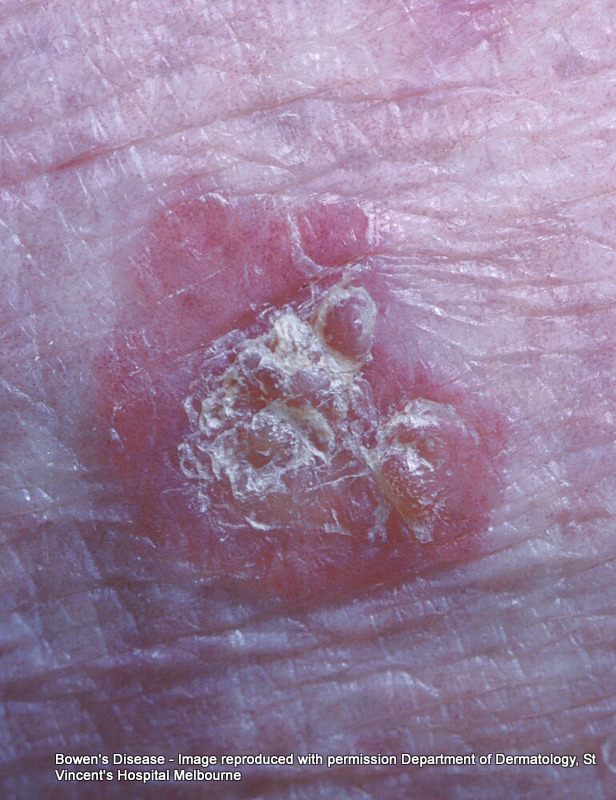Last updated: January 2024
Also known as: Intra-epidermal Squamous cell carcinoma or Squamous cell carcinoma in situ
What is Bowen’s disease?
Bowen’s disease is a common superficial cancer which occurs on the upper layer of the skin (the epidermis). It appears most commonly as a slow-growing, persistent red scaly patch on areas of skin exposed to the sun.
Who gets Bowen’s disease?
Risk factors for Bowen’s disease include:
- Ultraviolet (UV) radiation exposure
- Individuals with suppressed immune systems, either from medications or other medical problems, are at higher risk of Bowen’s disease.
- Arsenic exposure
- Human Papilloma Virus (HPV) infection
- Ionising radiation exposure
- Some rare genetic disorders
What causes Bowen’s disease?
The vast majority of lesions are caused due to UV exposure. UV damages the DNA, resulting in uncontrolled growth of the skin cells.
HPV is another major cause of Bowen’s disease.
What does Bowen’s disease look like?
Bowen’s disease frequently looks like a persistent red scaly patch that slowly grows over time. It most commonly appears on areas highly exposed to sunlight such as the face, neck, chest, arms and legs. Bowen’s disease can also occur on areas such as the lips, inside the mouth and the genital area. In these cases, it may look like an ulcer or thickened scar.
Bowen’s disease often causes no symptoms and hence there is delay in seeking treatment. It may be mistaken for other conditions such as dermatitis (eczema), or psoriasis, fungal infection (tinea), seborrhoeic dermatitis, lichenoid keratosis or porokeratosis.

Figure 1. Image reproduced with permission of A/Prof Robert Kelly

Figure 2. Image reproduced with permission of A/Prof Robert Kelly
How is Bowen’s disease diagnosed?
Bowen’s disease is usually diagnosed clinically.
A biopsy may be necessary to confirm the diagnosis.
How is Bowen’s disease treated?
Treatment options will vary depending on the individual and their needs.
The following treatments may be used to treat Bowen’s disease:
- Surgery including Mohs micrographic surgery
- Curettage and Electrocautery
- Cryotherapy or liquid nitrogen
- Topical chemotherapy, such as5-Fluorouracil (Efudix), Imiquimod (Aldara) and Ingenol mebutate (Picato)
- Photodynamic therapy (PDT)
- Radiotherapy
What is the likely outcome of Bowen’s disease?
If Bowen’s disease is not treated, a small percentage may develop into an invasive skin cancer, squamous cell carcinoma (SCC).
Individuals who have been diagnosed with Bowen’s disease should aim to protect their skin from further sun damage.
| Dr Davin Lim | January 2024 |
| Dr Davin Lim | October 2022 |
Disclaimer
2019 © Australasian College of Dermatologists.
You may use for personal use only. Please refer to our disclaimer.